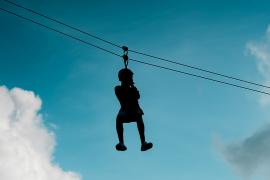The health center is a critical link in developing and maintaining a safe environment for your campers. However, providing adequate care to an active young population can be challenging. How should your health center be set up to best serve your campers? The following ideas will help you evaluate your health center and determine how you can provide adequate care while teaching campers personal responsibility.
Assess Your Situation and Set Goals
When evaluating your health center, your first step is identical to the nursing process and begins with an assessment. Followed closely behind is the redevelopment of goals. Ideally, both the camp director and camp medical director or nurse should be involved in the process.
Population served
Questions that need to be addressed begin with the desired level of care the camp will be capable and willing to provide (e.g., a basic first-aid station and triage center or a more complex level of a care requiring sophisticated equipment and a highly skilled staff of professionals). Part of this decision will be based on the population you serve, the length of camp sessions, and the activities offered. Will your population be mostly "well" staff and children? Will you expand to include differently abled children? If so, have you determined the review process and facility changes necessary to make their stay successful? Does your camp specialize in one particular type of illness or syndrome? Does your camp provide off-camp experiences? Do you offer unusual activities that might require special endurance or medical clearance?
Size of center
A determining factor for the size of your health center is accessibility of medical care in the surrounding community. Are you located in a rural area with only basic emergency care provided or is there a trauma-level hospital offering timely life flight services close by?
Contract of care
Another important piece of data collection is your contract with the parent for the level of care you provide and the type of disabilities and chronic illnesses you can reasonably support. Even if you are working with only "well" campers, you will need to be able to manage both environmental disasters, such as hurricanes and tornados, and medical disasters, such as an epidemic or a mass trauma.
Assess the Areas of Camp Impacted by the Health Center
Once you have established goals for the health center, the next step is to look at all the areas of camp the health center impacts.
- Campers and counselors: The health center provides medical support and supervision as needed, including medication management, temporary and long-term treatment of common episodic injuries and illnesses, and problem-solving difficult behavior and adjustment issues.
- Administrative staff: The health center keeps legal health records, maintains contact with parents when appropriate, and responds to urgent situations as they arise.
- Program staff: The health center ensures activities are planned safely and makes recommendations based on accidents treated. The health center might also provide first-aid kits specially designed for each activity with the specific supplies needed per predictable injury for that area and basic first-aid supplies and problem-solving support through radio consultation of sick or injured campers for off-camp experiences.
- Kitchen and housekeeping staff: The health center staff works closely with these individuals to ensure the public health of the camp.
- Camp budget: Providing appropriate medical care is not an inexpensive endeavor. Though a health center can be run frugally, it is no place to cut corners.
Properly Positioning and Equipping the Health Center
When planning the physical placement of the health center, the first area of concern is location within the general layout of the camp. A location that is central to the cabins is preferred over one that borders the camp. This location affords easy access in the middle of the night if the need arises, especially given the limited outdoor lighting of most camp settings. Plus, it has the added benefit of an "extra pairs of eyes" during the daytime for supervision. The facility needs to be kid friendly and easily accessible, yet at the same time not be mistaken for anther activity on camp. For many campers, the idea of seeking out help for their health-related needs is part of the learning experience of camp.
The health center building
The building needs to have flexible space. Keep in mind that during sick call as many as 5 to 10 percent of the camp population may be present for evaluation. The front area of the building requires an open space that allows for evaluating campers’ illnesses and injuries, a contact area for parent calls, and a storage area for charts and paperwork. Throughout the health center, locked storage space that protects supplies and equipment from the elements and camp critters is well worth the investment.
Space for semi-private outpatient examination and evaluation areas need to be set aside. The number of outpatient examining areas needed depends again on your present goals and number of campers. These areas should allow for evaluation and treatment of the camper and should be equipped with locked storage if medications are kept in the area. Many injuries at camp require soaking for cleansing and enhancing the health process, so you may want to designate an area for foot soaking. Each exam area should also have access to a sink for hand washing to control the spread of infection.
Depending on what level of care you are able to provide on camp, you may need a separate trauma/treatment room. This room would be set aside for urgent trauma evaluation, extensive ongoing assessment, suturing, minor surgery, and procedures. It may also double as a satellite laboratory for basic tests.
The inpatient area is another section that is dependent on the number of campers and the type of campers you service. Per ACA standards, approximately one inpatient bed is needed for every fifty people on camp for a "well" children’s camp. Adequate bathroom and shower facilities need to support the inpatient area. If you provide inpatient coverage at your camp, you will also need a kitchen area to feed the campers. This multipurpose area receives heavy use even if the number of inpatients is small.
Experience has also shown that the restrooms in the health center get very heavy use. In particular, "shy" campers seem to migrate to the seeming privacy of the health center restrooms.
Managing medications
Managing medication effectively and safely requires the health center to have a secure area where medicines can be stored and locked. This area will also need a sink and lockable refrigeration dedicated to medications only. As more children with chronic illnesses are able to enjoy a full life, they are also able to leave home and participate in a camp experience. They may bring with them a large compliment of medications. In recent years, as many as 30 percent of campers have arrived at camp with multi-dose maintenance medications.
To meet this increase, many camps are moving toward medicating campers as needed at mealtime in the dining hall where the campers are a captive audience. Experience has shown that this provides the best compliance with a medication schedule and is less complicated for the campers. It also helps separate the correlation of taking a medication and being sick at camp.
Electrical outlets and equipment
There never seem to be enough electrical outlets in a health center or adequate lighting. Separate refrigerators need to be maintained for food, medications, and laboratory needs. Many pieces of basic medical equipment, such as nebulizers and thermometers, also require electricity and specialty outlets. Also, if you are moving to upgrade the level of care by including monitoring equipment, you will need to have a constant source of predictable electricity with a back-up generator.
There is much discussion of late surrounding the inclusion of defibrillators in the camp’s health center. As with every new approach to health care, use of defibrillators would require year-round monitoring by staff and training in its proper use.
Infectious disease control
A contingency plan needs to be in place in the unlikely chance of an epidemic. Solutions might include expanding into cabins or general-purpose areas to isolate sick campers from their healthy cabin mates. An isolation room with a separate bathroom needs to be available in the event of highly infectious diseases such as meningitis.
Archival storage
One area that is often overlooked in the health center is a central storage location for archival of health charts. This requires an easily accessible space that protects the paperwork from damage and provides availability if the documents need to be retrieved in the off-season. The legal requirements differ from state to state as to the actual time that health records must be kept, but as a general rule, seven years past the age of majority (eighteen) is thought to be the regulatory requirement.
The Health Center as Part of Camp
Once all the hard work has gone into assessing, setting goals, collecting data, and formulating a workable plan, it is time to take a step back and evaluate how the health center is working within the camp system. Is it providing the expected care? Is complete documentation of medical care readily available in an easy-to-decipher form? Are preventive measures reasonable and are they making a difference? Are you able to keep your contract with parents? And lastly, is the health center a safe, camper-friendly place that provides the appropriate standard of care while teaching personal responsibility?
It is a tremendous responsibility to be trusted with the health care and safety of campers and young staff. The most impressive physical plant with sophisticated medical equipment has little value if it doesn’t have a well-trained staff of competent health care providers. Careful planning around camp goals for health care, the population of campers, and your contract with parents for health care can result in a well-balanced health center that is flexible to the camp’s needs, provides excellent care, teaches responsibility, and adds to the positive camp experience.
Nancy S. McMillan, RNC, FNP, is the founder of CamperCare, a consultation service. She has served as the health center director of a large nonprofit camp. She can be reached via e-mail at [email protected].
Originally published in the 2001 March/April issue of Camping Magazine.




